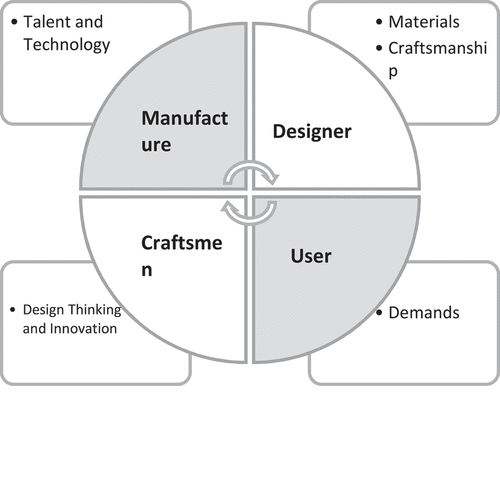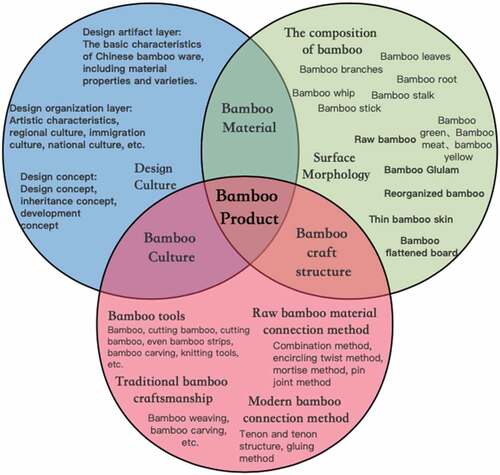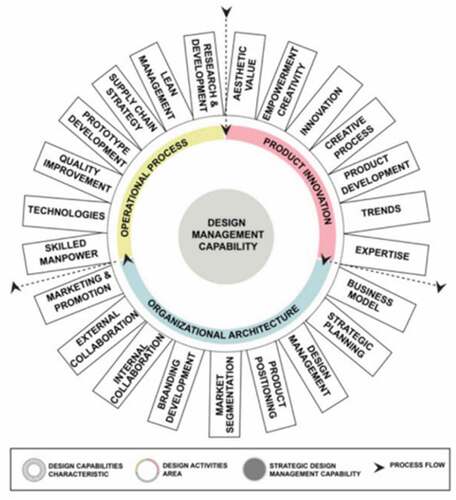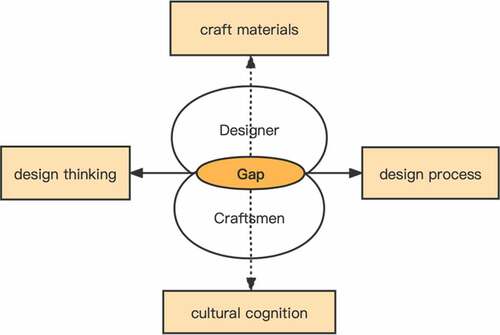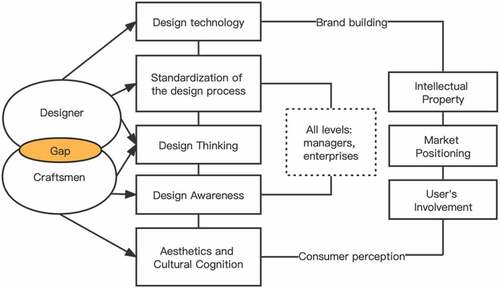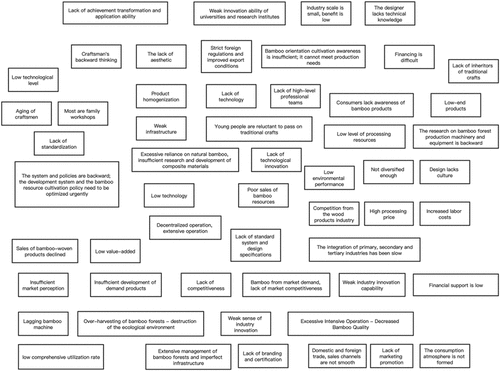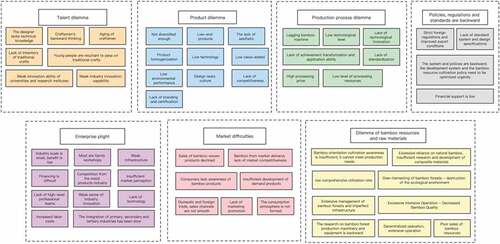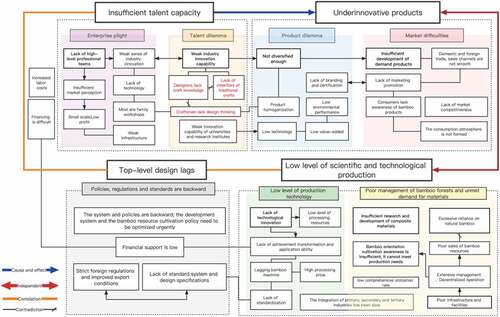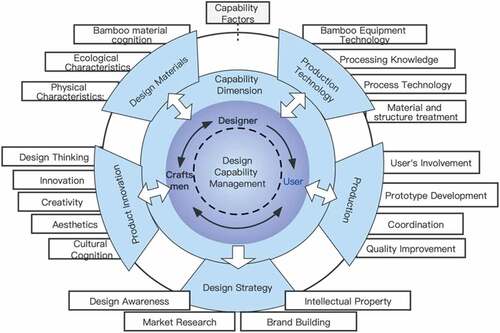Abstract
China is the main technology research and development country in the world’s bamboo industry, as well as the main producer and exporter of bamboo products. It ranks at the international leading level in terms of bamboo forest area, stock volume, bamboo product output and scientific research level. However, through literature review, it is found that the development of bamboo products in the modern social environment still faces many challenges. The author searched the keyword “bamboo product design” through CNKI and SCOPUS database systems, and initially retrieved 562 literatures. According to the screening criteria “Bamboo Product Design Status and Strategies”, and excluding redundant and repetitive studies, 76 papers were finally screened and identified. The author uses the A-type graphical tool of the KJ method to combine, classify and analyze the keywords in the “problem” literature, and use the relationship between these materials to organically combine and summarize these facts. It is found that there is a gap in capability between bamboo product designers and craftsmen. What is the gap between them? How to narrow the gap between them and improve their design capability? This is the research question of this study. To a certain extent, it is one of the key factors for the insufficient design innovation of bamboo products and the inability to meet consumer demands. Therefore, this study constructs a strategic framework of five capability dimensions by reviewing the literature on design capability management, combining product design standards and design capability demand theory, and incorporating the unique relevant factors of bamboo product design. The framework aims to improve the knowledge system and professional capability of craftsmen and designers to enhance the diversification and innovation of bamboo products, help the bamboo industry to clarify the market positioning of products, and meet people’s needs for bamboo products in modern life.
1. Introduction
Bamboo is an important ecological, industrial and cultural resource. China is a major bamboo producing country in the world. According to the “World Checklist of Bamboo and Rattan” published in 2017, there are 88 genera and 1,642 species of bamboo plants in the world, covering an area of more than 32 million hectares, accounting for about 4% of the world’s forest area and extremely rich in resources. Among them, China has 39 genera and 837 species of bamboo plants, accounting for about 20% of the global bamboo forest area, and is the country with the richest bamboo resources in the world (Benhua & Junwei, Citation2019). Under the trend of sharp decline in the global forest area, the bamboo forest area is increasing at an annual rate of 3%. According to the results of the Eighth National Forest Resources Inventory, the bamboo forest area in China is 6.01 million hm2 (Shiyu et al., Citation2017). China ranks first in the world in terms of bamboo forest area, stock volume, bamboo product output and export value, and is known as the “Kingdom of Bamboo” (State Forestry Administration of China, Citation2013.6). In addition, China’s bamboo industry development and scientific research level are at the international leading level, and it is the main technology research and development country in the world’s bamboo industry. China has applied for nearly 8,000 bamboo-related patents, accounting for about 50% of the world’s, and has bamboo-related national and industry standards 158 Items, accounting for more than 85% of the world’s total bamboo standards (Benhua & Junwei, Citation2019).
In June 2018, the National Innovation Alliance of Bamboo and Rattan Industry, which has been established for 4 years, finally formed a member structure with diversified membership of scientific research institutes, colleges and universities, associations and enterprise units. National Innovation Alliance of Bamboo and Rattan Industry, Citation2019). In July 2021, China’s State Forestry and Grassland Administration and the National Development and Reform Commission jointly issued the “14th Five-Year Plan for Forestry and Grassland Protection and Development Plan”. As a key project of traditional industries, the document emphasizes that the deep processing of bamboo products should be the development goal, and at the same time, vigorously develop the replacement of wood and bamboo, give full play to the contribution of the bamboo industry to carbon peaking and carbon neutrality, and achieve biological emission reduction and carbon sequestration (World Bamboo and Rattan Newsletter, Citation2021.7). In November 2021, ten ministries and commissions including the State Forestry and Grassland Administration of China jointly issued the “Opinions on Accelerating the Promotion of the Innovative Development of the Bamboo Industry”. The document also clarifies the main goals and tasks for the development of the bamboo industry, and proposes to achieve the goals before 2025, to develop new products and new formats, improve the capability of independent innovation, … to promote bamboo tasks such as deep integration of industry and bamboo culture. (World Bamboo and Rattan Communication Citation2021, (06), 104.).
It can be seen that the government and industry organizations have issued a large number of policies on the development of bamboo industry and bamboo resources, which have created favorable soft conditions for the development of bamboo industry. Under the guidance of policies, China’s major bamboo industry provinces, Zhejiang, Fujian, Sichuan, Guizhou and other provinces responded positively, made practical actions according to local conditions, issued opinions and requirements for the development of bamboo industry, and put forward their own development goals and principles. It has guided the direction and provided policy guidance for the transformation, revitalization and development of various industries, enterprises and individuals.
However, in recent years, there are still some opinions and suggestions on the development of bamboo products in the research field. Today, the glorious bamboo culture in my country is facing the problem of different quality standards and different production levels, which do not meet the psychological needs of contemporary consumers (Xing Y, et al, Citation2017). Most traditional bamboo products are aimed at low-end traditional markets, and the functions and forms of traditional bamboo weaving products can no longer satisfy people’s pursuit of an ECO lifestyle (Zhu, Shi, etc., 2019), ignoring emerging markets with higher added value (Xin & Yanling, Citation2017). Hungwei Lee (Citation2019) pointed out that many bamboo manufacturing enterprises and craft studios lack talents in the development process, lack of education and training in bamboo technology and production skills, and existing traditional craft skills need to be updated. In terms of design talents, College design graduates are generally unfamiliar with bamboo and lack bamboo knowledge and interest, which reflects the problems students will face as future designers (Lee, Citation2019).
The author reviewed 76 literatures on bamboo products through literature search and KJ method, and found that many studies have jointly emphasized the difficulties faced by bamboo products, which come from many perspectives. Among them, the first part of the literature review understands bamboo products in this research field. Some difficulties faced by development, among them, the most emphasized is the lack of innovation and the lack of talents (Xuanlin et al., Citation2019; Yutian et al., Citation2018); Unable to meet market demand (State Forestry Administration of China, Citation2013; Yanmin & Shuisheng, Citation2015); low technological content (Rui, Citation2020; Wenshan et al., Citation2021); single product and serious homogeneity (Cheng & Yongfa, Citation2012; Yong et al., Citation2022; Zhengjun & Benhua, Citation2019a; Zhonghua et al., Citation2021), lack of brand promotion (Wenshan et al., Citation2021; Yongquan, Citation2015), etc., bamboo products are far from the lifestyle and aesthetic needs of modern people, How to develop bamboo products that meet the needs of modern people’s life and aesthetic taste, and consumers’ low awareness of bamboo products (Yongquan, Citation2015), these have become a major problem for designers (zongdeng & Hongying, Citation2017).
In order to understand the main factors hindering the development of bamboo products, this study uses the KJ method to find that there is a causal relationship between the lack of bamboo product talents and the problems existing in bamboo product design. In modern life, traditional bamboo handicrafts are more artistic than functional, and modern bamboo products are functional and artistic. The main reason is the lack of design, which can realize the integration of the two and have a positive effect on the entire bamboo industry (Yanmin & Shuisheng, Citation2015). Cheng and Yongfa (Citation2012) also believed that the lack of products with core competitiveness and the lack of a unified brand in the bamboo industry market was mainly due to the restriction of enterprise talents, and proposed to strengthen the development of human resources and establish the concept of talent first. In terms of talent capability, current designers generally lack knowledge of bamboo craftsmanship, while bamboo craftsmen lack design thinking (Ying, Citation2013; Yutian et al., Citation2018), and there is an obvious capability gap between them.
Based on this, the second part of the literature reviews the research on the ability improvement of designers and craftsmen. Surprisingly, few scholars took bamboo product designers and craftsmen as their research objects, and there is still a very lack of literature on their capability improvement. Judging from the overall research status at home and abroad, the research focuses on the inheritance and protection of traditional bamboo craftsmanship, the innovation of regional culture and traditional bamboo products, the integration of traditional bamboo culture with modern lifestyles and aesthetic concepts. As well as the development of modern design concepts and the development of bamboo products under industrialized large-scale production conditions (Xiaolu et al., Citation2019). However, to improve the innovation of bamboo products, it is necessary to improve the R&D and innovation capabilities of enterprises, and more importantly, to strengthen team building (Rui, Citation2020). In view of the fact that there are still gaps in the field of research on the capability management of bamboo designers and craftsmen. In the third part, this study analyzes and discusses the theoretical model of design capability management by reviewing the related management strategy research of designers and craftsmen, review product design standards, design capability needs, combined with the relevant ability factors of bamboo product design, according to the status quo of designers and craftsmen. Finally, the capability factors of their respective needs are obtained. The author initially constructed a conceptual framework of design management for designers and craftsmen to improve their capabilities, in order to narrow the gap between designers and craftsmen, improve their design capabilities, and create more diverse bamboo products that meet market demand.
2. Literature review on the development status of bamboo products in China
2.1. Mass market demand
In the 1970s and 1980s, the rise and development of bamboo products was influenced by overseas markets. However, with the development of social economy, the development of bamboo products in China also faced some problems, such as Zhiyong et al. (Citation2005), said “the bamboo industry is still dominated by the domestic market and supplemented by the foreign market.” Until the financial crisis occurred, the direction of China’s bamboo product market has been changed, and it began to turn to the domestic market, trying to analyze the demand of the domestic market, However, affected by the previous business model based on OEM, the independent innovation ability of enterprises is generally weak, so they have encountered various development bottlenecks in opening up the domestic market.
The processing scale of bamboo products in my country is small and scattered, mostly small and medium-sized enterprises, and even family workshops, and the added value of bamboo products is low; the types and varieties of bamboo products lag behind wood products (Zhengjun & Benhua, Citation2019b.1), taking China’s bamboo weaving industry as an example, bamboo weaving The industry has always been in the manual, traditional and small workshop processing mode, and the lack of development concepts of modern design, industrial design, modern technology and integrated processing has seriously hindered the development of the bamboo weaving industry (Conghui et al., Citation2021). In addition, bamboo enterprises have been committed to developing foreign markets for a long time, while the domestic market is keen on price wars and lacks brand image and marketing planning (Xiaomei et al., Citation2021). Therefore, consumers’ awareness of bamboo products is not high, and the conversion rate of new products and new materials is low. Consumers’ awareness of bamboo materials is still a symbol of roughness and low price. There are misunderstandings about bamboo materials and defects, which greatly hinders domestic bamboo product development. Chinese traditional bamboo technology and modern bamboo products are facing the dilemma of marginalization and homogeneity respectively, unable to meet the needs of consumers and the market demand for bamboo products, resulting in low awareness of consumers on bamboo products (Qionghui et al., Citation2003; Wenshan et al., Citation2021; Yanmin & Shuisheng, Citation2015), the overall consumption atmosphere of bamboo products has not yet formed, which is one of the main reasons for the downturn of the bamboo products market (State Forestry Administration of China, Citation2013). Foreign scholar Koren (Citation2010) pointed out in his research that the target consumers of new bamboo products are global urban consumers, while the existing bamboo products are at a disadvantage in market competition. It can be seen from the above literature that market demand positioning is frequently proposed, and it can be seen that the market demand of bamboo products in the mass market needs to be re-investigated.
In fact, through the retrieval of bamboo product information, we can find some well-received bamboo products on the Internet, Taobao, Tmall and other commercial platforms, mostly kitchens, dining utensils, furniture products, and handicrafts. The application field of bamboo is still limited to these living appliances. In the information age of mobile Internet, electronic products such as mobile phones, stereos, electronic clocks, tablet computers, charging equipment, and network terminals have become an indispensable part of people’s lives. The modernization of bamboo Demand design should broaden the field, and many designers have made such attempts. For example, Zongdeng And Hongying (Citation2017) proposed the design concept of “half-bamboo” design, and designed a series of bamboo products based on the half-bamboo design, including electronic device charger accessories, mobile phone shells, tablet computer shells, speaker accessories, tablet The computer stand and mobile phone stand are shown in Figure . And a series of designs combined with metal accessories, a set of stationery items combined with bamboo and metal, including staplers, etc.
Figure 1. Bamboo accessories electronic products design & Bamboo and metal combination(zongdeng & Hongying, Citation2017).

There are also some branded bamboo products sold on the platform. However, many monthly sales show zero, but the products are very delicate and well-designed bamboo products, such as LEICKE and Wheat Orange brand bamboo audio. It can be seen that these bamboo products The manufactured products are not yet familiar and used by consumers. There are still many high-quality bamboo creative design works that have been promoted on competition websites or some literature studies, but they have not been marketed, and physical products cannot be obtained in the mass market. It is difficult for the team to insist on meeting the diverse needs of the market. However, some scholars are optimistic and believe that challenges are also opportunities, pointing out that bamboo products urgently need to develop the domestic market with unlimited potential (Yan & Yu de, Citation2014). Some scholars believe that bamboo products can meet the living requirements of contemporary people through reasonable design (zongdeng & Hongying, Citation2017). Hicks (Citation2014) emphasizes that the ultimate goal of production is to produce what consumers want, not what companies want. In order to remain competitive and gain significant market share in the marketplace, designers must be able to attract consumers to consume them goods or services, which can be achieved by applying good design (Norzaman et al., Citation2017).
To sum up, to change the predicament faced by bamboo products, design is the main strategy, while enterprises, manufacturers and individual designers and craftsmen are the main producers, and their ability level in innovative design is very important.
2.2. Enterprises & manufacturers
From the analysis of the development of bamboo industry in various regions, we can understand the obstacles encountered by enterprises and manufacturers in the development of bamboo products.
Taking Zhejiang Province, which is the first echelon of China’s bamboo industry, as an example, in the face of high-tech products such as wood, metal and plastic, the market competition of traditional bamboo products is not dominant, coupled with the gradual decline of the traditional bamboo products industry, the ability of bamboo enterprises to develop new products is generally weak, and craftsmen generally lose confidence (Wu Ping, Citation2010). There is a phenomenon of insufficient innovation ability in the industry (Yong et al., Citation2022). 95% of bamboo processing enterprises in Zhejiang Province are private enterprises. Due to the different competencies of designers and craftsmen, the development of products is polarized. Taking Longyou County as an example, most enterprises focus on simple primary processing of bamboo, and there is a serious shortage of leading enterprises in deep processing. The bamboo industry’s technological innovation and achievement transformation and application capabilities are insufficient, and the independent innovation ability needs to be improved urgently (Zhonghua et al., Citation2021).
Yunnan bamboo processing enterprises are all over the province, but the scale of the enterprises is small, and there is no leading processing enterprise with high product correlation, large scale, deep processing and strong driving ability. There are 364 bamboo product processing enterprises in the province, and provincial leading enterprises 9 households. Most bamboo product processing enterprises are small in scale, develop few high-precision and deep bamboo products, and have low product added value (Yongquan, Citation2015). Taking the processing enterprises in Zhaotong City as an example, the scale of the enterprises is generally small, and most of the small workshops are processing the same type of products. The technical content is low, and the quality is difficult to guarantee, which greatly affects the development of the bamboo industry, and even causes Therefore, it is urgent for these enterprises to promote the diversified production of bamboo products, so as to meet the needs of the market (Rui, Citation2020). There are more than 2,600 bamboo and related products processing enterprises in Guangdong, and there are many products, but the overall level of bamboo resource processing and utilization in Guangdong is still very low. Most bamboo processing enterprises are mostly family workshop-type private enterprises, and the degree of mechanization, continuity and automation needs to be upgraded., Most bamboo product processing enterprises have less than 10 employees, lack of scientific and technological content, and low product added value (Wenshan et al., Citation2021).
Anji County is known as “China’s Bamboo Township”. Anji County in Fujian has established 26 moso bamboo demonstration parks, and there are more than 920 bamboo processing enterprises in Anji, ranking first in the country at the county level, but there are fewer than 40 enterprises above designated size. In addition, the overall industry innovation ability is insufficient, and the update iteration is slow, mainly reflected in: the processing technology is still dominated by bamboo weaving, bamboo furniture, reorganized bamboo, mechanism mats, etc. The industry has a weak sense of innovation and lack of innovation vitality (Yongquan, Citation2015).
IN Hubei and Anhui provinces, there are more than 1,200 bamboo industry processing enterprises in the two provinces, including 51 processing enterprises above designated size. Mainly, bamboo handicrafts are supplemented by bamboo culture and eco-tourism and other intangible bamboo resources management pattern, built two online and offline trading platforms, enterprises have carried out FSC forest certification, production and marketing chain of custody (COC) certification and The EU’s CE certification, etc., has vigorously carried out bamboo forest eco-tourism. However, from a national perspective, the two provinces are both in the middle and lower levels in terms of resource cultivation and processing and utilization, the coexistence of production and processing capacity expansion and idle production lines, the healthy development of leading processing enterprises and the coexistence of losses and closures of small and medium-sized enterprises. The environmental protection problems of small and medium-sized enterprises in the processing and utilization of bamboo materials have not been fundamentally solved, and the phenomenon of bamboo products mildew occurs from time to time, insufficient scientific and technological support and innovation ability have become important factors restricting the healthy development of the bamboo industry (Henggui et al., Citation2014; Xianwu & Daoping, Citation2020).
It can be seen that the standardization of bamboo is far from keeping up with the pace of industrial development. Because many enterprises are transformed from family workshops, the scale of enterprises is small, the technical content of products is low, and the market competitiveness is insufficient. There is no scientific and reasonable arrangement in team formation and enterprise planning, lack of industrialized operation, lack of market-competitive enterprises to drive productivity, most production enterprises can only produce primary bamboo products (Fan Zhiquan, Citation2020), and the overall innovation ability is weak (Wang et al., Citation2020). Therefore, in order to reverse the current predicament faced by the bamboo industry, Governments at all levels and relevant departments have successively put forward some policies in recent years, emphasizing that the bamboo creative industry should attach importance to innovation-driven, and use design innovation to enhance the recognition and brand influence of bamboo products (Xiaolu et al., Citation2019). The above studies mainly reflect the relationship between talents that hinder the development of bamboo products, especially small and medium-sized enterprises, lack of deep processing ability, weak innovation ability, lack of high-tech products (Xiaolu et al., Citation2019) and other problems, restricting the benefits of enterprises and degree of transformation.
Therefore, it is very important to increase the proportion of design talents in ordinary small and medium-sized enterprises. According to relevant survey data, there are about 90 million professional designers in the world, of which nearly half are in Asia (about 43%), and the number of design practitioners in mainland China alone is about 17 million, and a large number of design graduates continue to pour into the design industry every year in our country(The data comes from big data analysis, the status of Chinese designer industry). It can be seen that how to better coordinate and cultivate design professionals in bamboo products is the key factor to improve the quality and innovation level of bamboo products.
2.3. Designers and craftsmen
The downturn of the bamboo industry has caused many bamboo technical talents to turn to other industries, leading to the outflow of traditional bamboo craftsmen, the traditional craftsmanship is on the verge of being lost (Yanmin & Shuisheng, Citation2015), the lack of bamboo craftsmanship talents, and the lack of traditional craftsmanship creativity (Xuanlin et al., Citation2019) and so on are common. Nowadays, many experts, scholars and the government have begun to pay attention to the protection and inheritance of traditional craftsmanship, but the coverage is small, or more of a formality. The reason is that the research intervention from the design perspective is relatively lacking, which is one of the important factors (Xiaolu et al., Citation2019). Some scholars pointed out that the development of bamboo products is mainly restricted by the backward thinking and technology of craftsmen (Min Jun & Yue, Citation2016). Brata (Citation2009), from the perspective of craftsmen, took bamboo handicrafts as an example, emphasized the function of education, and analyzed the impact of innovation education on the innovation index of bamboo products. He believed that craftsmen need to learn to innovate. Xudong and Aihua (Citation2019); Xiaolu et al. (Citation2019) also emphasized that the design of modern bamboo products can inherit, understand and apply bamboo culture through the understanding of bamboo culture or the perspective of regional culture, explore the ontological value of bamboo culture, and stimulate innovative vitality. Combining with modern bamboo processing methods and processing techniques, we can design products that conform to modern aesthetics and reshape the bamboo product innovation system. However, through literature review, it can be seen that many traditional craft inheritors operate in the family mode, and the aging is relatively serious, and the cultural cognition level of the artisan group is generally low, that is, there is a gap in cultural knowledge between artisans and designers. Take Anji County Take the processing of bamboo weaving products as an example, because it requires physical production to facilitate the decision of the plan, but most craftsmen do not have modern equipment such as computers and cameras (Ying, Citation2013), and the craftsmen are lacking in the capability to operate modern equipment and design thinking.
There are few related studies on how to improve the ability of craftsmen, but China attaches great importance to craftsmen and handicraft talents. On the one hand, it is for the purpose of protecting the traditional skills of craftsmen, and on the other hand, it puts forward requirements for the artisan group to adapt to the knowledge and information age. For example, As early as in the report of the 19th National Congress of the Communist Party of China, China clearly proposed to “build a knowledge-based, skilled and innovative workforce, and promote the spirit of model workers and craftsmen … ” (Yong et al., Citation2022). Zhanyong and Xueyuan (Citation2018) put forward that the core qualities of craftsmen are craftsman spirit, ingenuity spirit and craftsman soul through interviews with 39 craftsmen in their daily work and life. They divided different types of craftsmen into four categories: skilled, consummate, technical, and innovative according to their different expertise, levels, and values. Judging from the number of each level, it is like a pyramid. The higher the level, the less the number of innovative talents. Therefore, these living cultural and technical talents must be protected and utilized. It is very necessary to understand the status quo of capabilities and put forward relevant strategies.
Through interviews and literature review, the author learned about the craftsmen who run independent workshops and those who work in enterprises. The process of making bamboo products is shown in Figures . The bamboo product production process of the municipal bamboo craft inheritor is shown in Figure . According to the description of the inheritor, we can initially understand the source of product orders, one is the online scattered customer demand, the other is the third-party entrusted processing, and the third is some personal orders, free creation. The main source is still order production. However, the types of these products are also limited by their own processing conditions, and are generally primary processed products such as bamboo weaving and raw bamboo. As shown in Figure , the craftsman door in the manufacturing industry only plays the role of production tools, and does not participate in the design or communication procedures. There is no design thinking (Ideo, Citation2016) involved in the process of production ideas. In terms of production technology, they only follow their own areas of expertise and lack the ability of independent innovation. In such a large-scale production line, it is difficult for craftsmen to improve their own ability level.
Figure 2. The thinking process of the inheritor of bamboo weaving products.(By the author)Source:Interview with Liu Jiasheng, the inheritor of bamboo weaving in Lingshan, Guangxi.
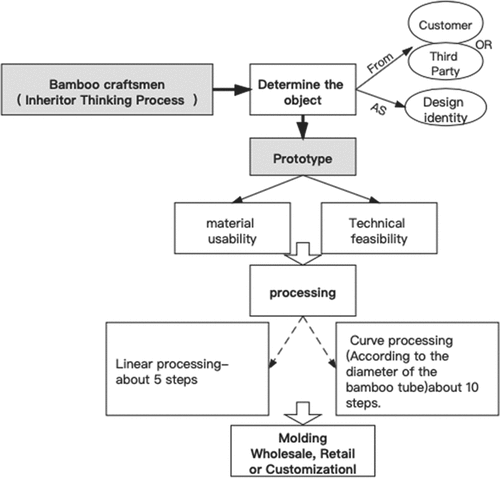
Figure 3. The thinking process of bamboo craftsmen in the factory/enterprise. The author modified the production process based on the design of Anji bamboo woven products. Source: Ying (Citation2013).
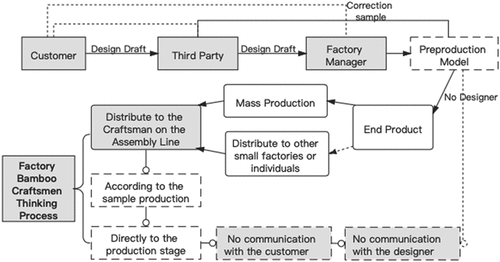
In contrast, designers generally view the design process as an iterative learning process, as shown in Figure , starting from requirements definition, to the end of product testing, and then to commercialization. It can be seen that the product development process of artisans is much simpler, They see this process as a linear production process, from new concept to finished product and market, they do not understand the real needs or problems of customers through empathy and definition, and lack the process of design conception and iteration. Therefore, in the process of product development, there is a clear gap in thinking ability between craftsmen and designers.
Figure 4. Ideo, design thinking transforms organizations and stimulates innovation. Wanjuan Publishing House Banerjee B., Gibbs T. (Citation2016).

Regarding the discussion of bamboo product designers, there are relatively few relevant materials. From the perspective of education, Lee, Citation2010) found that design graduates are still relatively unfamiliar with the use of bamboo materials and lack interest in bamboo or bamboo knowledge, which reflects the students’ The problems that designers will face in the future are that designers lack the ability to use bamboo materials and process knowledge. There are also scholars who have analyzed the design communication modes and problems of modern bamboo products in Anji and Taiwan through field research. She believes that in Taiwan’s Yii brand, there is an obvious gap between craftsmanship and design, the roles of craftsmen and designers are different, and Issues such as the distribution of intellectual property rights (Ying, Citation2013).
Ge (Citation2011) also emphasized that the innovation ability of bamboo product practitioners in scientific research institutes and universities in new technologies, new products, new processes, and new equipment needs to be further strengthened. Ying (Citation2013) analyzed the problems existing in the design and communication of bamboo products in Anji, and her discussion reflected that the development of today’s bamboo products mostly relies on third-party customers, and the lack of independent innovation by enterprises is not conducive to the sustainable development of bamboo products. This reflects the current situation of the lack of talents in bamboo design from the side, which leads to the weak innovation ability of the bamboo industry as a whole (Wang et al., Citation2020). value and create benefits for economic development (Nianwen & Jun, Citation2014).
To sum up, bamboo enterprises or manufacturers in many provinces in China generally have weak awareness of innovation, lack of technical and talent support in the development of high-precision products, and imperfect talent structure, which eventually leads to relatively weak new product development capabilities, and the market is ineffective. Bamboo products cannot meet the living needs and aesthetics of modern people; Designers and craftsmen are the main product development groups. Designers have relatively low awareness of bamboo craftsmanship, bamboo materials and production technology, which makes the development of some products often stay in the creative stage, the development of the product has encountered many difficulties; However, craftsmen have limited ability to innovate new crafts and new technologies, and they are also facing the status quo of aging. Not only do they lack innovative awareness and design thinking, but also there is a lack of successors in the inheritance of craftsmanship, which makes it difficult for traditional bamboo products to open up sales. It makes it difficult for craftsmen to develop some products that meet mass consumption through design.
In a word, bamboo product designers, craftsmen, and enterprises (manufacturers) are faced with the dilemma of insufficient talents or abilities, and ultimately affect consumers. As shown in the Figure :
In this context, in the face of the gap between craftsmen and designers in the bamboo industry: craftsmanship, cultural knowledge, design thinking, design process, it is necessary to think about a strategy that can improve the design capabilities of designers and craftsmen. In order to promote the diversified and innovative development of Chinese bamboo products. The next part of this research takes design capability management as the theoretical basis from the perspective of the ability improvement of designers and craftsmen. Analyze the capability factors that bamboo product designers and craftsmen should have.
3. Literature review of design capability management
3.1. Design management
The concept of design management has been put forward for more than 50 years. Michael Farr, who first proposed the definition of design management, emphasized the importance of the designer’s role. He believes: “Design management is to define design problems, find suitable designers, and try to let designers solve design problems in a timely manner within the established budget.” After the concept of design management was proposed, under the influence of industrialization, the design concept expanding, collaboration between companies and teams such as designers, engineers, marketers, etc., has received more attention (Haiou, Citation2021). Xianyi (Citation2014) believes that design management is aimed at the confusion of enterprise design style, the lack of design principles, and the lack of unified management of design resources. Integrate the knowledge of design and management to manage a series of design strategies and design activities. It is conducive to cultivating designers and management talents, promoting the integration and intersection of disciplines, establishing a sound design management system for enterprises, and formulating design strategies. The importance of design management to the design team is evident.
Looking back on the history, we can find that the early design management thinking about capabilities has been practiced by relatively mature companies, such as MMF, which pays attention to the building of team capabilities to meet the needs of consumers. For example, William Mo, who is known as the father of modern design Reese, whose ideas enrich the meaning of design and designer. He believes that the artist is not a genius, but a cooperative partner, “the artist and the designer are actually one” (Zhenji & Zheyuan, Citation2017). MMF attaches great importance to the coordination of work between teams; it advocates satisfying consumers through design, coordinating the different viewpoints of designers and manufacturers, continuously updating design concepts and innovative thinking, and ensuring artistic value and production efficiency; By observing market dynamics, MMF responds to market changes in real time, forms a professional team, and produces products that meet market needs (Xiaolu et al., Citation2019, 4). It can be seen that William Morris emphasizes the integration of professional teams to cooperate and innovate to meet the needs of consumers and manufacturers.
The author reviewed the literature on design management models, expecting to find content about designers and craftsmen. The review found that many scholars in the design process management mentioned that the design process is mainly an activity performed by designers and teams. For example, Pahl & Beitz’s design process model explains tasks and requirements at different stages, but does not directly mention the division of tasks and cooperation between designers and other participants (Library, Citation1996), the framework is more complex, Compared with this study, a clear task allocation and a reasonable management model are needed more. Cross’s design process model is divided into two levels: main problem and sub-problems, overall solution and sub-solution, interspersed between steps, feedback, iteration and decision-making (Cooper et al., Citation2000). However, its only decision-making and production phase is between modifying the scheme details and determining the scheme, which can lead to more time-consuming and onerous iterations of the task, unfortunately, the model also does not mention the task level of the participants. Therefore, from the perspective of personnel task allocation, the model is not clearly depicted.
The above models all emphasize the importance of iteration from the perspective of the design process. Although they do not mention the form of work assignment and participant cooperation, they also confirm the main problem of this research from the side. Designers generally have a design thinking mode, while craftsmen are the exact opposite.
Fabian Wolff and Amaral (Citation2016) analyzed from the perspective of design, and the concept of design was analyzed from different perspectives and gradually expanded: design—business strategy—design method—design process; design team—team capability—capability the effective implementation of; social needs—design differentiation—design benefits—design strategies. It emphasizes the multiple dimensions of design, the design process, the design team and the design strategy. The design of this model is relatively comprehensive, but the relationship between the dimensions is somewhat ambiguous. For this study, we would like to see specific tasks and task implementation. The cooperative relationship between the designers and the craftsmen in the whole design process is conducive to the standard of measuring the ability of bamboo product designers and craftsmen. Cheng & Yongfa, Citation2012.12) thinks that if the design manager can manage the designers well, the management will have a 70% chance of winning. He also refers to the designers participating in the design activities according to the level of design ability and the roles they assume in the design work. The importance of the design and the influence on the entire design project and design process divide the categories of designers. Liu, X.H. and Rieple, A. (Citation2019) constructed three stages of entrepreneurial work mode, reallocation of resources and knowledge construction when studying the solutions and capability factors in the entrepreneurial stage of Xiaomi enterprises. Emphasis on engaging customers to improve product quality; transforming work models, flexible work processes for cross-functional collaboration, and leveraging knowledge to foster innovation. As early as 2003, RHMAN and KAAA researched the role of knowledge cultivation and transformation, and assisted the knowledge transformation of industrial clusters in Malaysia through design management practices. Form a common underlying conceptual framework for the knowledge transfer process for designers, organizations and their relationships, and create knowledge transfer strategies.
The research viewpoints of some of the above scholars are worth learning from, management of the design process, such as Parr & Beitz and Cross, and an emphasis on iterative design perspectives;team competency management emphasized by Fabian Wolff et al.; Sylvia, L. and Alison, R. Cross-functional collaboration, fostering innovation with knowledge, engaging customers to improve product quality, and RHMAN et al. (Citation2003) emphasized the role of knowledge transformation, which played a guiding role in this research for the knowledge gap research of designers and craftsmen, and how to bridge the gap.
3.2. Design management of designers
As a modern professional concept, “designer” was born in the late 19th and early 20th centuries, and the construction of professional roles and social status can be traced back to the architects of the Renaissance (Zhenji & Zheyuan, Citation2017). The concept evolution from craftsmen to designers has undergone changes in social productivity and experienced artists. The replacement of group ideology. Although the title of “designer” became popular only after the Industrial Revolution, the concept of “designer” as engaging in “planning, conceiving and planning” has been established during the Renaissance (Zhenji & Zheyuan, Citation2017). John S. Kuhl explained the concept of “designer”, that is: a designer is a person who is engaged in design work, through education and experience, with knowledge and understanding of design, and design skills and techniques, and can successfully complete design tasks., and get the corresponding compensation” (quoted from Zongdeng, Citation2014.5)
The change of the design role will affect the change of the society’s demand for the designer’s ability, and some researches on managing the designer’s capability will be discussed next.
Zhonghua et al., Citation2021) carried out the management research of designers from the perspective of enterprise talent selection. They believe that it is necessary to start from the selection mechanism and training mechanism of designers to study what management methods are conducive to finding suitable designers., and let designers grow continuously in the enterprise, increasing the knowledge and creativity of designers. How to find suitable designers, Chen Yan (Citation2016) proposed a capability model oriented training pyramid and capability echelon diagram. As shown in Figure , the selection of suitable designers can refer to the competency model, which will play a solid foundation for building an efficient team. Personnel with different competencies have different ranges of competencies. It is beneficial to improve the efficiency of design activities by clarifying the needs of the industry.
Industry requirements for product design, Miao (Citation2011) analyzed the role changes of industrial design based on the development process of product design. He believes that in most modern enterprises, industrial designers participate in the entire product design and manufacturing process, and they have industrial design capabilities with mechanical design capabilities. The designer has also participated in the entire design activities from market research and data processing to sales planning, and the connotation of the designer is also quietly changing. The business capability of a designer who reflects the needs of today’s society from the side is no longer just the expression of creative design, they also no longer just play the role of fire brigade and decorator. Due to the wide variety of manufacturing processes for product forming, the processing processes such as materials and machinery also pose challenges to the designer’s ability, which requires the designer not only to understand the knowledge of mechanical processing, but also to have a clear understanding of the processing technology of different materials. Only in this way can we communicate with professional designers to complete the design and production of works together (Miao, Citation2011).
In addition to the product industry’s capability to demand designers, some scholars put forward that designers are knowledge workers. According to the definition of management master Peter Drucker, knowledge workers are “people who master and use symbols and concepts, and work with knowledge and information”. Yuesheng (Citation2006) explored the management strategy of knowledge-based employees. He took designers as an example to illustrate the characteristics of this group: the owner of knowledge capital, whose structural capital contains knowledge assets that have been transformed into codes; Full ownership of your own expertise. However, this part of knowledge assets or human capital is a part of corporate capital that is easy to be lost. In fact, according to the previous literature review, bamboo craftsmen are losing talents, and many traditional bamboo skills are facing loss. Bamboo craftsmen are also knowledge-based employees. A group of skills in a specific field is also a talent that is being lost. For knowledge workers, Wang Yuesheng (Citation2006) put forward several management measures: people-oriented management, flexible work, autonomous working environment, etc. However, there is no detailed elaboration of relevant strategies for capacity management.
Therefore, based on the viewpoints of the above scholars, the article needs to understand the range of capabilities required by bamboo product designers, the design and production procedures of bamboo products, the knowledge and technology involved in each link, etc., so as to determine the range of capabilities and needs of bamboo designers.
3.3. Craftsman design management
The management of artisans has long appeared in ancient China, and the establishment of slavery society promoted the emergence of the craftsmen class.
The first stage, the Baigong system in the Western Zhou Dynasty, provided an important institutional guarantee for the handicraft production in the slave society. Since the Qin and Han dynasties, the central government established a system of managing and recruiting craftsmen according to household registration. These management methods gradually evolved into a strict craftsman household system (Huanxu, Citation1996, p. 63). The third stage is the establishment of a multi-layer administrative operation and management system. In the Tang Dynasty, there were many types of government-run handicrafts and a large scale, and a multi-layer administrative operation and management system from the central to the local was established (Jing, Citation2018). The craftsmen produced almost all kinds of products according to the needs of the feudal government. These products are only used by the ruling class and do not participate in the exchange of goods. In the fourth stage, in order to consolidate management and stabilize a large number of high-quality craftsmen, the rulers of the Yuan Dynasty incorporated a large number of craftsmen into special household registrations, called “artisan households. The government centralized management of handicraft producers, and classified them into special household registrations for management, descendants and grandchildren.” One after another, they cannot renounce their nationality; handicraft producers have no freedom of production and personal freedom, and cannot marry independently (Jing, Citation2018). The fifth stage, developed to the Ming Dynasty, gradually formed a complete craftsmanship management system. The craftsmen in the Ming Dynasty had a clear division of labor and strict levels, and became a model of “classic creations” in the history of Chinese craftsmanship. Finally, in the Qing Dynasty, the artisan household system that lasted for four and a half centuries officially came to an end.
Under the system jurisdiction of the above dynasties, the brand awareness of craftsmen was born, for example, the supervision system of “Wule Work Name”. The information of the maker, supervisor, manufacturing institution, etc. of the utensil is engraved on the item, and the responsibility is placed on the person, so that the government can Assessing the performance of craftsmen and officials (Jing, Citation2018).
Looking back on history, we can’t help feeling the evolution of the identity of craftsmen. Craftsmen played a very important role in the past life and production. They used almost pure manual production methods, with a very professional attitude, superb skills, and strict management. Under the system, it has made a great contribution to the society.
After the arrival of the industrial age, they gradually withdraw from the stage of history, but today, China still attaches great importance to the attitude of traditional craftsmanship.
In March 2016, Premier Li Keqiang mentioned the spirit of craftsmanship for the first time in the government work report of the National “Two Sessions”. Premier Li Keqiang also pointed out in the government work report, “Encourage enterprises to carry out personalized customization and flexible production, cultivate the spirit of craftsmanship for excellence, increase varieties, improve quality, and create brands”. China’s “14th Five-Year Plan” and the outline of the long-term goals for 2035 put forward: “deeply implement the project of inheritance and development of Chinese excellent traditional culture, strengthen the systematic protection of important cultural and natural heritage and intangible cultural heritage, and promote the creative transformation of Chinese excellent traditional culture, innovative development.” Haiou (Citation2021) believes: “This requires us to further innovate the means of communication, enhance the empowerment of science and technology, protect and inherit the intangible cultural heritage, and continue to promote its integration into modern life and reflect contemporary values … ”.
The management of craftsmen, in the context of modern society, is more inclined to focus on the management of the spirit of craftsmen, because the spirit of craftsmanship has become increasingly scarce in the social context. Jin (Citation2016) put forward the contemporary value of the craftsman spirit in his research. He believes that the craftsman spirit is the soul of the manufacturing industry and the guarantee of high-quality life. On this basis, he proposed the cultivation path of craftsman spirit, one of which is: give full play to the educational function of vocational colleges and provide a basic guarantee for the cultivation of craftsman spirit. That is, to cultivate future designers, they must inherit the craftsman spirit and craftsmanship skills., which is conducive to shortening the gap between designers and craftsmen.
Craftsmen, as important inheritors and production groups of bamboo products, are a very key group that affects the market and consumer demand. Unfortunately, in the field of bamboo products, there are very few special researches on craftsman ability improvement strategies. Moreover, from the perspective of the development status of bamboo products, design talents and craft talents are in short supply.
Since there are still gaps in the research on the capacity management of designers and craftsmen. To better represent the underlying problem (Li et al., Citation2020), based on the problems and status quo of the above literature, the following literature review will combine industry design standards, product design capability requirements and bamboo product development demand capability factors, Three aspects to determine the dimension of their design capability needs.
4. Factors of design capability of bamboo designers and craftsmen
This section will measure the deficiencies and gaps between bamboo product designers and craftsmen based on industrial design standards, bamboo product design capability factors and product design capability requirements.
4.1. Industrial design criterion
Industrial design standards refer to the design specifications and evaluation criteria of humanized indicators and performance indicators that are advanced and effective under industrial design conditions, are suitable for industrial production methods, can be understood and may be tested and implemented, and reflect environmental protection principles and market values. It is not only the basis for design innovation, but also the stimulating condition for innovative thinking (Lan Cuiqin, Citation2019). The selection and adoption of standards for standardizing industrial design activities is directly related to the success or failure of products.
Regarding the content of design standards, some scholars have studied it for a long time. Shengnan and Rong (Citation2006) put forward design standards that can evaluate a product by analyzing the history and development of design evaluation standards around the world, they are technology, economy, society, human, machine, environment, system and aesthetics (Shengnan & Rong, Citation2006). Xiaolu et al. (Citation2019) put forward thinking on design standards from another perspective. Through the analysis of value goals, value orientations and value realization means, he divided product evaluators into four categories: consumers, enterprises, and social People and eco people. Then according to these 4 different groups of people, convert their product requirements into product standards.
The author believes that a more comprehensive and systematic design standard is the theoretical model of the industrial design standard technology system established by LanCuiqin (Citation2019) by analyzing the connotation of the industrial design standard technology system and combining the background knowledge of engineering, aesthetics, psychology, economics and other disciplines. As shown in Figure .
Figure 7. A theoretical model of standard technical system for industrial design(Lan Cuiqin, Citation2019).
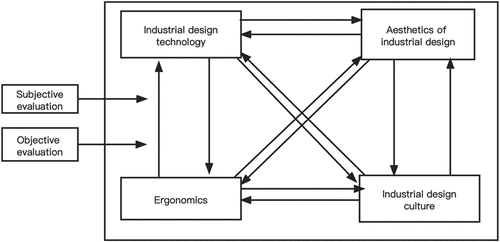
The four indicators of technology, aesthetics, ergonomics and culture in this model form an organic and unified whole. Each standard in the system is a sub-standard of the industrial design standard, and each sub-standard will be affected by some elements. For example, technology The standard includes elements such as structure, color, material, and technological processing; the ergonomics standard includes psychological and physiological elements; aesthetics includes functional aesthetics, formal aesthetics, technical aesthetics, social aesthetics, etc., of which technical aesthetics will also be related to technology, material and Human-machine relationship is related; finally, cultural elements mainly refer to hidden elements such as aesthetic taste, cultural spirit, etc. Therefore, in industrial design culture, it specifically refers to elements such as cultural symbols used in design (Lan Cuiqin, Citation2019).
The research attempts to define the talents that designers and craftsmen should have through design standards. The elements in the technical standards can be described as the basic literacy that integrates design skills, which is the part that artisans are relatively lacking. The implementation of design culture requires the “realization” of certain creative thinking. However, it will be limited by the current production methods of bamboo products, and designers are also faced with difficulties, and the use of culture is the shortcoming of craftsmen. In the design of products, designers usually need to consider two levels, one is the safety, comfort and ease of operation of the product, and the other is the aesthetics of the product and the harmony of the wood environment (Ruisi, Citation2017). Therefore, Ergonomics provides theoretical guidance and scientific basis for bamboo product design. Design should find a balance between aesthetics and practicality. Aesthetics needs to consider the cognitive factors of consumers. Traditional bamboo products are less reflected in this aspect, ignoring the modern aesthetic needs of consumers, and it is also a part of craftsmen that is lacking. Therefore, The four indicators of technology, culture, aesthetics, and ergonomics can be included in the ability indicators of designers and craftsmen. In addition to industry standards, scholar Liu Guoyu once proposed the scope of product design, as shown in Figure : There are also places worth learning from.
Figure 8. Scope of product design (Xiaolu et al., Citation2019).
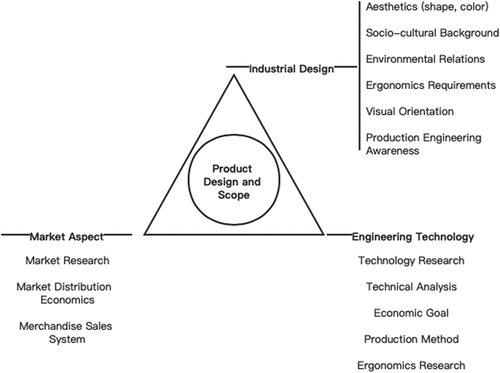
The Figure shows that the scope of product design includes industrial design, which includes aesthetics, social and cultural background, environmental relations, ergonomic requirements, visual positioning, and production engineering awareness. From the perspective of bamboo product design, cultural background and The two indicators of environmental relationship are also closely related to this study. Bamboo is an environmentally friendly material, which should be emphasized; in addition, bamboo culture has a very long history and should not be forgotten. The second scope of the model is the engineering-technical aspect, which covers technical research, technical analysis, economic goals, production methods, and ergonomic research. In terms of technical indicators, this point is somewhat different from Lan’s division. As for technical research, technical analysis and production methods, they are the basic dilemmas faced by bamboo products. These have been described in the first part of the literature review and will not be repeated here. The third is the market aspect. It includes market research, economics, and commodity sales systems. What Liu and Lan have in common is their emphasis on industrial design, technology and aesthetics. In the author’s research, aesthetics and social culture are discussed separately. In Liu’s (Citation2000) research, the market factor is also added, which is an important aspect of product design. The author agrees with this point of view, because Bamboo products are mentioned the most is that they can not meet the market demand.
To sum up, combined with the difficulties faced by bamboo products, the capacity building of bamboo product designers and craftsmen should refer to the following indicators:
Aesthetics and cultural cognition: design aesthetics (function, form, technology), bamboo culture;
Design technology: structure, materials, process treatment, technical research and analysis, production methods, ergonomics;
Market Research: Market Positioning, Consumer Engagement, Economics, Merchandising Systems.
4.2. Factors of bamboo product design capability
Bamboo product design involves a lot of scope. Compared with the design standards mentioned above, the special properties and processing of bamboo materials should also be considered. Bamboo has a long history of development in China. This section finally summarizes three main aspects. They are bamboo culture, including spiritual culture and material culture, the second is bamboo materials, including physical and ecological characteristics, and the third is bamboo craftsmanship, including handcraft. Technology and mechanical technology, these three aspects are the special ingredients that are different from other material products.
First of all, bamboo culture is a culture based on bamboo, which is an important part of Chinese culture. It mainly refers to all the cultural forms related to bamboo created in history, including the material culture and spiritual culture related to bamboo in history (Wang Ping, Citation2001). It is a carrier of ideas and cultural symbols. According to the Western cultural semiotics, bamboo products are more of a design symbol (Yutian et al., Citation2018), which is the main innovative way of bamboo cultural and creative product design in modern bamboo products.
The second is bamboo material. There are many kinds of bamboo in China, and the materials of different bamboo varieties will be different. The growth year, physical structure, toughness, etc. will affect the material selection and design of bamboo products. Zongdeng And Hongying (Citation2017) combined the physical properties and texture of bamboo, and designed some simple and beautiful products by using “half-bamboo” design, material combination design, cultural transplantation and other design methods. Dan (Citation2014) discussed the feasibility of using bamboo to replace raw wood in the design and development of toys from the perspective of environmental protection. This is mainly because bamboo also has strong hardness and warm texture compared with wood, it is also environmentally friendly and sustainable.
Finally, bamboo products will involve a lot of technical skills or experience, molding technology and material handling, and even equipment operation. Jin (Citation2016) discussed the contemporary value of craftsmanship, and mentioned that craftsmanship is the soul of manufacturing. There are many processing techniques for bamboo and bamboo products, which can be divided into manual techniques, mechanical techniques and special techniques according to the operation mode. According to the processing method, according to the information currently available, in addition to the common processing and forming processes such as sawing, profiling, planing, weaving, etc., there are also reconstituted bamboo forming processes, bamboo-wood composite laminated wood forming processes, and molding and hot bending forming processes (Xiaokai, Citation2009). This process knowledge is an important part of the bamboo product design capability requirements.
According to the above description, the factors involved in the design of bamboo products are shown in the Figure .
4.3. Product design capability
There are many studies on designers’ capabilities, such as Weijun et al. (Citation2008), two domestic art designers, through the key behavior event interview method and group focus interview method, investigate the incumbents and related personnel, and obtain the designer’s competency structure model. Through the measurement of the behavior scale, the structure of the seven competency modules is verified, including design ethics, work attitude, interpersonal understanding, professional skills, creativity. power, self-management, and organizational identity. The spider web model developed by Heskett and Liu (Citation2012; Figure ) is based on standardization of the design process, design work assignment (flexibility), internal design (talent pool), company size, design awareness, design Competitive awareness is used as an indicator to measure design capability. On this basis, in 2014, Stovann, Jensen and Christensen developed the “Design Competency Framework” (Figure ), which covers 5 aspects: Design Awareness, Design in Process, User Engagement, Innovation drive and design capabilities.
Figure 10. Design capability model from China (Heskett & Liu, Citation2012).
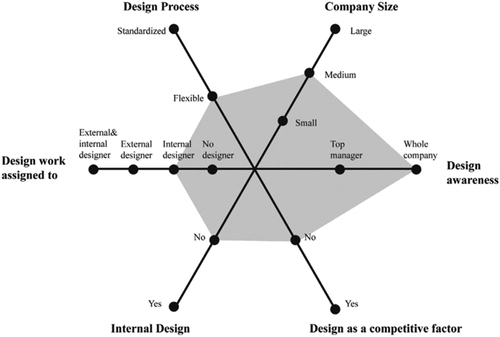
Figure 11. Design capacity framework from the Danish perspective (Storvang et al., Citation2014).
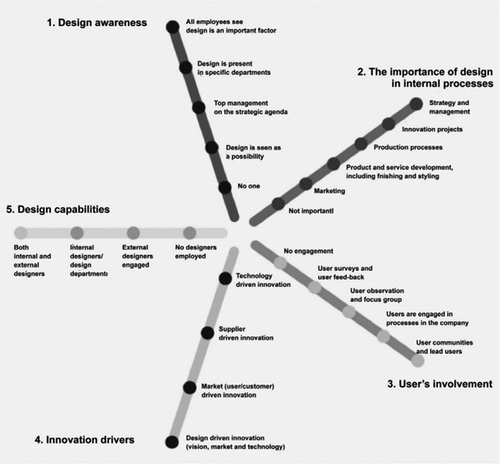
The standardization of the design process of this model (Figure ), the production and design of traditional bamboo products lack certain standards, and the industry standards are not perfect. Cuiqin (Citation2019) pointed out that standards have industry characteristics and dynamic characteristics, and its proposal requires design with the participation of teachers. The level of design awareness of this model, in the field of bamboo products, designers are basically possessed, while craftsmen, managers, and companies are relatively lacking. Of course, this has a certain relationship with the scale of the company.
The design competency framework (Figure ) proposed by Stolwan, Jensen, and Christensen (Citation2014) emphasizes user involvement in the company’s design process and innovation drivers. This enriches the dimension of the design capability model and emphasizes the original purpose of product design, which is to serve consumers.
Of course, product design is indispensable to creative design, but some scholars emphasize the importance of design thinking capability in the cultivation of creativity. Xiaoyong and Long (Citation2018) believe that cultivating creative learners is the focus of the current education field …, they also found through case analysis that the application of design thinking can help promote the development of students’ advanced thinking ability …, they proposed three core elements of the design thinking process: observing design challenges, connecting ideas and solutions, reflecting on and improving design, which is an iterative process, there are similarities with IDEO’s design thinking process mentioned in the previous literature.
There are also some specific industry-to-case studies on design capabilities. For example, Osman and Rahman (Citation2019) took Malaysian local furniture manufacturers as the research background and demonstrated that design capabilities affect the business performance of domestic furniture manufacturing companies. Therefore, in order for local manufacturers to remain and continue to be competitive in this industry, there is a need to enhance organizational design capabilities. As shown in the Figure , the scope of product innovation capabilities proposed by the study: aesthetics, intellectual property, innovation, creative process, product development, trends, expertise.
The product homogeneity, vicious competition, and lack of brands mentioned in the status quo of bamboo product development. If you pay attention to the protection of intellectual property rights, trademark registration, product patent and copyright applications can play a role in ensuring that this situation can be avoided. In addition, in the process of product innovation, creation and development, introducing design thinking, clarifying and clarifying the content (tools and tasks) of each stage, in order to more accurately find and solve problems, improve the rationality of product development, and also help to improve the production efficiency of products. The role of design thinking here tends to be more of a management role. It can regulate and guide the way designers and craftsmen work.
To sum up, the dimension of design capability covers more and more extensive and more professional, because only in this way can it play a scientific guiding role for a certain industry. In the field of bamboo product design, the ability indicators of designers and craftsmen are mainly constructed from the following directions:
First of all, we describe the gap between designers and craftsmen through the above literature review, as well as the gap with product design capability requirements, as shown in Figure , to clarify the individual capability differences between craftsmen and designers, mainly referring to materials and Differences in craftsmanship, design process, cultural perception, etc.
Secondly, through literature review, combined with the relevant ability factors of bamboo product design, as well as the standards of product design and the theory of ability demand, three main directions for the ability construction of designers and craftsmen are summarized, as shown in Figure . One is the related factors of bamboo product design, that is, the lack of knowledge of crafts and materials by designers, and the lack of awareness of bamboo culture by craftsmen; The second is based on the factors required by product design standards. It mainly includes four aspects: aesthetics and cultural cognition, design technology, and market research. The third is the designer’s ability standard. It mainly includes: standardization of the design process, design awareness, user participation, design thinking, and intellectual property rights.
According to the design capability indicators in these three directions, This study will further construct a more detailed, factor-inclusive management framework for capacity improvement. This part will be presented in the final discussion section.
5. Methodology
This study uses literature research method and KJ method as the main research methods. In order to understand the factors that hinder the development of bamboo products, through the KJ method, the research questions are found, that is, what is the ability gap between designers and craftsmen, and how to improve their capabilities ?To help develop diversified bamboo products to meet the needs of consumers. The research constructs a conceptual framework by reviewing the literature on the ability management of designers and craftsmen, as well as the related competency factors of bamboo product design. It is expected to enhance the ability of designers and craftsmen to meet the diverse needs of the mass market for bamboo products.
5.1. Literature summary and analysis
The research mainly summarizes, analyzes and organizes the existing relevant literature, research reports and other materials. The literature review is divided into three themes: the development status of bamboo products, related literature on design ability management, and the ability factors of bamboo designers and craftsmen. The first part analyzes the development status and challenges of bamboo products. From the literature from CNKI, 483 related literatures are obtained by searching the keyword “bamboo products”, including 20 main themes and 20 minor themes. Among them, there are 3 doctoral dissertations, 16 master dissertations, 362 academic journals, and 7 conference papers. By screening the titles and abstracts, and removing the literature that is not related to bamboo product design research, 183 papers are identified. By carefully reading the research questions and research purposes, including 115 articles discussing the current situation and strategies of bamboo product design. Because it is to understand the development status of bamboo products and some strategies proposed by the research, in order to understand the background of the research more quickly, the literature reviewed the literature in the past 10 years, that is, between 2012 and 2022, CNKI collected a total of 97 articles. 16 redundant studies were excluded, and 81 were left. According to the complete correlation with bamboo product design, 14 were removed and 67 were left. With the same screening criteria, the Scopus database was searched: TITLE-ABS-KEY (bamboo AND product AND design), and a total of 79 papers were searched since 2003, including 39 conference papers and 38 research papers. Look at the title and abstract to remove the literatures that are not related to bamboo product design research, there are 14 literatures about bamboo products; delete 2 that are repeated with CNKI, and there are 9 related literatures related to the current situation and strategy research of bamboo products in the past ten years. Seven of them are about the design status and strategy of bamboo products, and the protection of bamboo crafts. One is about the development of the interactive communication platform for bamboo products. The other is about the application of simulation technology in the design of modern bamboo products. The current literature has finally identified 76, as shown in Figure . The number of literatures on design capabilities in the second and third parts is relatively small, and has not been included in the statistical scope of systematic literature.
Figure 15. Systematic literature search process. (By author, reference source:Thoring et al., Citation2020).
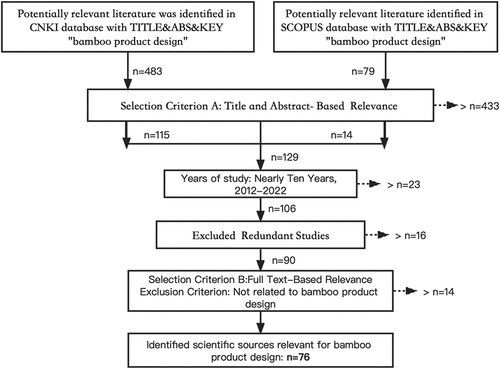
In the first part, through the literature review, it is found that there are many studies discussing the lack of design innovation, the backward technology, and the inability to meet the market demand. These problems in the design of bamboo products, the relationship between them, and what are the most important problems? Through the analysis of the KJ method (the detailed process is in the next section), the research shows that there is a causal relationship between the lack of talent ability of bamboo products and the problems existing in the design of bamboo products. Designers lack process knowledge, while craftsmen lack design thinking, so it can be inferred that there is a gap in ability between the two;
The research continues through literature review and found that there are very few studies discussing designers and craftsmen. The research can initially find that there is a gap in the ability of designers and craftsmen in the process of bamboo product design by analyzing the process of craftsmen and designers designing bamboo products. This makes bamboo products have two extreme development directions, one is the design products that do not flow to the market due to the production conditions; the other is the traditional bamboo products that do not meet the needs of the public;
Based on the above phenomenon, the second part systematically reviews the management strategy research related to designers and craftsmen, selects the classic theoretical model of design management cases for analysis and discussion, and finds that there are still gaps in the research on the ability management of bamboo designers and craftsmen;
The third part reviews the ability factors of product design, the designer’s ability standards and the related ability factors of bamboo product design, and measures the current situation of designers and craftsmen. A conceptual framework for craftsmen design capacity management.
5.2. KJ hod——A graphic method
The KJ-method is basically similar to the snowball technique developed by Japanese ethnologist Jiro Kawada in 1960. The tool used in this study is the A-type diagram (as shown in the Figure ), which is a method of classifying and synthesizing a large amount of factual, opinion or conceptual linguistic data collected on a particular topic according to their relationship to each other. By capturing the different opinions, ideas and experiences of researchers, and a large number of facts truthfully, and use the relationship between these materials to organically combine and summarize these facts, discover the whole picture of the problem, establish hypotheses or create new theories, It is conducive to breaking the status quo and carrying out creative thinking.
Figure 16. Basic steps of the KJ Ho method (Kunifuji, Citation2016).
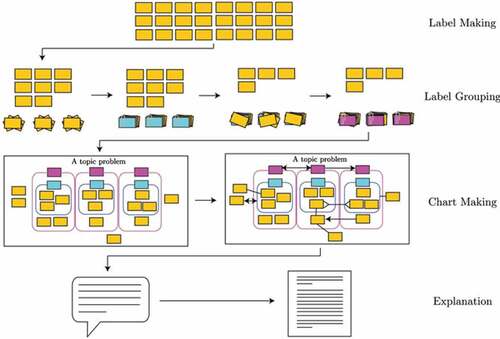
First, through literature analysis, the KJ-method was used to label and classify the keywords in the 76 selected literatures. Through this method, many keywords related to the development status and problems of bamboo products were extracted, as shown in the Figure ,
Secondly, record and classify the words with high frequency, as shown in Figure , classify the tags according to the relevance, and think and describe a suitable title for each group. The title should be suitable for all the content of the tag, not too abstract Can’t be too specific (Kunifuji, Citation2016, P65). Finally, 7 tags are grouped.
Third, after several label grouping steps, the process of label grouping and label naming is repeated, and it is necessary to continue to converge labels until all labels and groups converge to a problem. Eventually, the number of groupings is reduced to 4, and a label group is named a subject, Figure .
Finally, it is necessary to analyze the relationship between labels and the relationship between label groups, and analyze the relationship between high-frequency words and questions according to the classification results. Ultimately identifying the most important or obvious research questions, this is the purpose of the KJ approach.
As shown in Figure , through the steps of the KJ method, the final analysis shows that there is a causal relationship between the lack of bamboo product talent ability and the problems existing in bamboo product design. In the label group of lack of talent ability, there is still a contradiction. See, Figure , under the theme of lack of talent ability, in the talent dilemma label, designers lack process knowledge, while craftsmen lack design thinking, through this phenomenon can be inferred, there is a capacity gap between the two.
6. Discussion
Through the analysis of the above content, we understand that the development of bamboo products faces many difficulties. Among them, designers and craftsmen are groups with different professional ability characteristics, and there is a gap in ability, which has been emphasized in many studies, which affects bamboo Product diversification. This phenomenon is common in China’s main production areas and small and medium-sized enterprises. In some well-known enterprises, designers and craftsmen are a common combination team, and most of the craftsmen belong to external cooperative teams, which have certain unstable factors. In view of this, through literature review, this study found that there is still a lack of research on the ability improvement of designers and craftsmen in the current research field, and the research on designers and craftsmen of bamboo products has not been mentioned, and there is a research gap.
Therefore, based on the above literature review, combined with product design standards and design capability requirements, this study measures the missing capabilities of bamboo product designers and craftsmen, as well as the ability gap between designers and craftsmen themselves, and draws the following 5 benefits for designers and craftsmen (Figure ). The dimension of craftsman capability improvement. They are: product innovation, design materials, production technology, production production, and design strategy. These five dimensions are expanded from the previous Figure , with more levels and more comprehensive dimensions. Since the previous design technology scope includes professional design skills and technology, in order to see more clearly the strategy to narrow the gap between designers and craftsmen, it is finally divided into product innovation (including design thinking and aesthetics) and production technology, material and production dimensions; Considering that design awareness and intellectual property are closely related to management and corporate level, the dimension of design strategy is set up, which includes design awareness, market research, brand building and intellectual property. Based on this, the corresponding 21 capability factors were subdivided, which were also discussed in the literature review. As shown in the figure, the conceptual framework of design capability management of bamboo product designers and craftsmen.
7. Conclusion
The significance of this article is to implement effective competency design management strategies to enhance the competencies of bamboo product designers and craftsmen. The article mainly analyzes the problems that need to be solved mainly because of the capability gap between designers and craftsmen through the literature review method and KJ method. Therefore, this study proposes a conceptual framework of design management for the improvement of the capability of designers and craftsmen by combining the design capability model in the management field, the standards of product design and the related factors of bamboo product design. The framework aims to improve the knowledge system and professional capabilities of craftsmen and designers, and is conducive to the diversification and innovation of bamboo product development. The research focuses on user needs, helps the bamboo industry to define the market positioning of products, and meets people’s needs for bamboo products in modern life. While promoting the design value of bamboo products, it also has a certain role in promoting the integration of sustainable design and development concepts.
Disclosure statement
No potential conflict of interest was reported by the author(s).
Additional information
Funding
References
- Banerjee B.& Gibbs T. (2016). Ideo, design changes everything – How design thinking transforms organizations and stimulates innovation. Wanjuan Publishing House.
- Benhua, F., & Junwei, L. (2019). Bamboo industry for continuous carbon sequestration. Land Greening, 07, 11–30.
- Big data analysis of Chinese designer industry status. http://www.sohu.com/a/211615883_188910
- Brata, A. G.,Innovation and social capital in the small-medium enterprises: A case of bamboo handicraft in Indonesia. Globelics 7th International Conference “Inclusive Growth, Innovation and Technological Change: education, social capital and sustainable development”, Dakar, Senegal, 6-8 October, 2009. Paper No. 15696, Paper No. 15696.https://mpra.ub.uni-muenchen.de/15696/MPRA
- Cheng, B., & Yongfa, Z. (2012). Analysis of current situation and countermeasures of bamboo industry development in Zhejiang Province. Economic Research Guide, 251, 175–178. http://gfffg0d5ea2b984614a3csf0pcbp5kcbqb6f65.fgfy.bsuc.cwkeji.cn/kcms/detail/detail.aspx?FileName=JJYD201225074&DbName=CJFQ2012
- China issued “opinions on accelerating the innovation and development of bamboo industry”. (2021). World Bamboo and Rattan Newsletter, 6, 104.
- China’s “14th five-year plan” outline of forestry and grassland protection and development plan was released to grasp the opportunities of “14th five-year plan” to better integrate bamboo and rattan into the overall development of forestry and grassland. (2021). World Bamboo and Rattan Newsletter, (4)
- Conghui, J., Yujing, H., Shuyan, Y., & Benhua, F. (2021). Significance and suggestion of intelligent development of China’s bamboo weaving industry. World Bamboo and Rattan Communication, 19(4), 8–12+20. http://gfffg0d5ea2b984614a3csf0pcbp5kcbqb6f65.fgfy.bsuc.cwkeji.cn/kcms/detail/detail.aspx?FileName=ZTTX202104007&DbName=CJFQ2021
- Cooper, R., Bruce, M., & Vazquez, D. (1999). Effective design management for small businesses. Design Studies, 20(3), 297–315. https://doi.org/10.1016/S0142-694X(98)00022-2
- Cooper, R., Olson, E., & Stanley, S. (2000). Managing design for competitive advantage: A process approach. DMI Review, 11(4), 10–17. https://doi.org/10.1111/j.1948-7169.2000.tb00143.x
- Cuiqin, L. (2019). Research on the technical system of building industrial design standards. Packaging Engineering, (14), 99–105. https://doi.org/10.19554/j.cnki.1001-3563.2019.14.018
- Dan, F. (2014). Research status of biomass resource utilization. Jiangxi ChemicalIndustry, 4(22), 71–73. https://doi.org/10.14127/j.cnki.jiangxihuagong.2014.04.022
- Ge, W. 2011. Talking about promoting the development of China’s bamboo industry with scientific and technological progress. Journal of the Academy of Management Cadres of the State Forestry Administration, 4(5), 8–11. CNKI:SUN:BJGL.0.2011-04-005.
- Liu Guoyu. (2000). Product Design. Shanghai Jiaotong University Press.
- Haiou, Z. (2021, July 12). China’s intangible cultural heritage protection is eye-catching. People’s Daily, 008.
- Henggui, L., Banquan, R., Deli, X., Shuang, G., & Lijun, X. (2014). Investigation and suggestion on the development of bamboo industry cluster in Xianning, Hubei[J]. World Bamboo and Rattan Communication, 12(5), 41–46. https://doi.org/10.13640/j.cnki.wbr.2014.5.010
- Heskett, J., & Liu, X. 2012. Models of developing design capacity: Perspective from China. International Design Management Research Conference, Boston. Leading_Innovation_through_Design_Proceeding.
- Hicks, J. (2014). Economic theory and the evaluation of consumers’ wants. The Journal of Business, 35(3), 256–263. https://doi.org/10.1086/294509
- Huanxu, C. 1996. Ancient Chinese craftsmen. Commercial Press International Co., Ltd: 9787801030818 63.
- Industry Renewal, Faculty of Health, Art and Design School of Design Swinburne University of Technology, 2019, p 68.
- The international bamboo and rattan organization and the united nations industrial development organization signed a cooperation agreement. (2021). World Bamboo and Rattan Newsletter, 05, 93–94.
- Jin, L. (2016). A summary of the forum on the cultivation of “craftsman spirit” in vocational education. China Vocational and Technical Education, 34(27), 37–40. http://gfffg0d5ea2b984614a3cscvfnbvqpbuk96c9k.fgfy.bsuc.cwkeji.cn/kcms/detail/detail.aspx?FileName=ZONE201627006&DbName=CJFQ2016
- Jing, C. (2018). The emergence and evolution of craftsman spirit under the ancient Chinese craftsman system. New Art, 11(7), 34–39.
- Jingjing, L., & Rong, P. 2016. Analysis of bamboo product design based on diversified demand. Journal of Design, (7), 120–121.
- Koren, G. (2010). New bamboo product for the global market. An Analysis and Exploration of Opportunities. 1–99. http://evendimmen.nu/Gijsbert%20Koren%20Bamboo%20product%20windmill.pdf
- Kunifuji, S. (2016). A Japanese problem-solving approach: The KJ Ho method. In Knowledge, information and creativity support systems: Recent trends, advances and solutions (pp. 165–170). Springer, Cham.
- Kunifuji, S. (2016). A Japanese problem-solving approach: The KJ Ho method. In Knowledge, information and creativity support systems: Recent trends, advances and solutions (pp. 165–170). Springer.
- Lee, H. (2019). Reviving Taiwan’s bamboo manufactured products sectors: a case for design-led industry renewal [ Doctoral dissertation]. Swinburne University of Technology.
- Lee, L.-S., Chang, L.-T., Lin, K.-Y., Lee, Y.-C., & Lin, S.-W. (2010) A study of the function map for cultural and creative professionals of bamboo handicrafts in Taiwan, 19, 29–57. http://rportal.lib.ntnu.edu.tw/handle/20.500.12235/35567
- Li, T., Kou, G., & Peng, Y. (2020). Improving malicious URLs detection via feature engineering: Linear and nonlinear space transformation methods. Information Systems, 91, 101494. https://doi.org/10.1016/j.is.2020.101494
- Library, P. (1996). MRS. Bulletin, 21(8), 71. https://doi.org/10.1557/S0883769400035776
- Liu, S., & Rieple, A. (2019). Design management capability in entrepreneurship: A case study of Xiaomi. International Journal of Design, 13(3), 125–138. http://www.ijdesign.org/index.php/IJDesign/article/view/3446
- Miao, S. (2011). Industrial Product Modeling Designer and Design Management. Tianjin Design Society. (Eds.) Proceedings of International Innovation Design and Management Summit Forumin 2011 & the Second Design Academic Conference of Chinese World wide (IDM2011) (pp.47–49). Scientific Research Publishing, USA. https://doi.org/10.13640/j.cnki.wbr.2006.01.007
- Naganobu, M., Maruyama, S., Sasase, M., Kawaida, S., Kunifuji, S., & Okabe, A. (2012). The editorial party of field science KJ Ho: Exploration of natural fusion, thought and possibility of field science. Shimizu-Kobundo-Shobo, Japan (in Japanese) (Note: Published as a Kawakita Jiro Memorial Collection issue covering various topics of Fieldwork Science and the KJ Ho).
- National innovation alliance of bamboo and rattan industry. (2019). World Bamboo and Rattan Newsletter, 6, 2.
- Nianwen, W., & Jun, L. (2014). The integrated development of design services and bamboo industry in the context of cultural and creative industry revitalization. Seeker Journal, 10(1), 175–178. https://doi.org/10.16059/j.cnki.cn43-1008/c.2014.10.035
- Norzaman, N. Z. A., Shaari, N., Rahman, K. A. A. A., Utaberta, N., & Jaafar, J. M. (2017). Integrating Asma ul Husna values for design excellence. Pertanika Journal of Social Science and Humanities, 25, 33–40.
- Osman, N. S., & AbdRahman, K. A. A. (2019). Strategic design management capability framework for Bumiputera SME furniture manufacturer. International Journal of Advanced Science and Technology. Special Issue in Applied Research on Business, Science and Technology, 28 (8s).
- Ping, W. (2001). Origin and characteristics of bamboo worship in southern minorities. Journal of Hubei University for Nationalities (Philosophy and Social Sciences Edition), 4(5), 21–25. https://doi.org/10.13501/j.cnki.42-1328/c.2001.04.005
- Ping, W. (2010). Advantages, problems and countermeasures of China’s development of bamboo industry. World Bamboo and Rattan Newsletter, 06, 29–32. https://doi.org/10.13640/j.cnki.wbr.2010.06.012
- Qionghui, W., Yunxin, L., & Dingqiu, G. (2003). Current situation and countermeasures of Guangdong bamboo industry development. Non-wood Forest Research, 04, 159–161.
- RHMAN, K. A. A. A., Sugiyama, K., & Watanabe, M. (2003). Knowledge conversion strategies for Malaysia industrial clusters. In Journal 6th Asian Design International Conference, Tsukuba, Japan.
- Rui, C. (2020). Thinking about technical service strategies in the development of bamboo industry in Zhaotong City. Southern Agriculture, 14(33), 168–169. https://doi.org/10.19415/j.cnki.1673-890x.2020.33.081
- Ruisi, S. (2017). On the current situation and development of product design in the new era. Changjiang Series, 16, 26.
- Shengnan, C., & Rong, P. (2006). Exponential quantitative research on industrial design evaluation criteria. Journal of Zhejiang Sci-Tech University, 23(4), 461–465.
- Shiyu, H., Yuan, Z., & Xiaomei, J. (2017). Study on spatial distribution characteristics of bamboo place names in china. Journal of Bamboo, 36(3), 11–18. https://doi.org/10.19560/j.cnki.1000-6567.2017.03.002
- State Forestry Administration of China. (2013, 6). National bamboo industry development plan, state forestry administration (2013-2020).
- Storvang, P., Jensen, S., & Christensen, P. R. (2014). Innovation through design: A framework for design capacity in a Danish context. Design Management Journal, 9(1), 9–22. https://doi.org/10.1111/dmj.12006
- Thoring, K., Mueller, R. M., Desmet, P., & Badke-Schaub, P. (2020). Spatial design factors associated with creative work: A systematic literature review. Artificial Intelligence for Engineering Design, Analysis and Manufacturing, 34(3), 300–314. https://doi.org/10.1017/S0890060420000232
- Wang, G., Fuming, C., Haitao, C., & Jinhe, F. (2020). The characteristic advantages and innovative development of China’s bamboo industry. World Bamboo and Rattan Newsletter, 18(6), 6–13+29. https://doi.org/10.12168/sjzttx.2020.06.002
- Weijun, Z., Hanqing, C., & Tao, D. 2008. An exploratory study of designer competency model. Journal of Nanjing University of Aeronautics and Astronautics (Social Science Edition), 4(204), 42–46. https://doi.org/10.16272/j.cnki.cn11-1392/j.2010.04.012
- Wenshan, L., Ruiquan, X., & Qun, L. (2021). Development strategy of bamboo industry in Guangdong province based on SWOT analysis. Tropical Agricultural Engineering, 45(6), 68–71.
- Wolff, F., & Amaral, F. G. (2016). Design management competencies, process and strategy: A multidimensional approach to a conceptual model. Strategic Design Research Journal, 9(3), 145–154. https://doi.org/10.4013/sdrj.2016.93.02
- Xianwu, Z., & Daoping, L. (2020). Current situation and countermeasures of bamboo industry development in Hubei and Anhui provinces. World Bamboo and Rattan Communication, 18(4), 66–69.
- Xianyi, Y. (2014). Design management. China Construction Industry Press, p. 159.
- Xiaokai, Z.(2009). Research on the Design Law of Bamboo Product System under Multiple Design Paradigms (PhD dissertation, Jiangnan University). http://gfffg0d5ea2b984614a3csk6cfwwux6wn66nbu.fgfy.bsuc.cwkeji.cn/KCMS/detail/detail.aspx?dbname=CDFD0911&filename=2009250283.nh
- Xiaolu, L., Xinzhu, W., & Xueting, X. (2019). Research on the innovative design of bamboo products from the dual perspective of “Internet + Regional Culture” (Vol. 02, pp. 32–36+52). Art Life-Journal of Fuzhou University (Art Edition).
- Xiaomei, B., Lixia, L., & Ziqiu, Z. (2021). Suggestions for promoting high-quality development of bamboo industry in Suichang, zhejiang. World Bamboo and Rattan Communication, 19(2), 75–78 https://doi.org/10.12168/sjzttx
- Xiaoyong, H., & Long, Z. (2018). Design thinking models and cases for cultivating creativity. Modern Distance Education Research, (3), 75–82. https://doi.org/10.3969/j.issn.1009-5195.2018.03.009
- Xin, J., & Yanling, M. (2017). Research on innovative design of bamboo product structure based on e-commerce. Journal of Guangdong Institute of Petrochemical Technology, 27(01), 62–65+70.
- Xing, Y., Zhi, F., & Shan, G. (2017). The new life of bamboo: The innovation direction of contemporary Chinese bamboo products. https://doi.org/10.13337/j.cnki.packaging.world.2017.02.025
- Xuanlin, Z., Xin, S., & Yuan, G. (2019). The application of generative design method in the design of fast-growing wood products: Taking bamboo products as an example. Industrial Design, 8, 99–100.
- Xudong, L., & Aihua, G. (2019). Design innovation of modern bamboo products based on traditional bamboo culture. Science and Technology Innovation Herald, 08, 221–222. https://doi.org/10.16660/j.cnki.1674-098X.2019.08.221
- Yan, C. (2016). Analysis of Design Management - Design Management of Design Teams. Industrial Design Industry Research Center. (Eds.) Industrial Design Industry Research Center Vol. 4) (pp. 139–143).
- Yan, Z., & Yu de, G. (2014). Market prospect of bamboo products in Northeast china. Bamboo Research Journal, 3(11), 60–64 CNKI:SUN:ZZYJ.https://doi.org/10.2014/0003-011
- Yanmin, W., & Shuisheng, T. (2015). Research on the application of traditional bamboo craftsmanship in modern product design. Design, 7, 98–99. http://gfffg0d5ea2b984614a3csxpocubu9o005659v.fgfy.bsuc.cwkeji.cn/kcms/detail/detail.aspx?FileName=SJTY201507038&DbName=CJFQ2015
- Ying, D. (2013). Comparison of design communication between Anji and Taiwan’s modern bamboo products. Design, 08, 38–39.
- Yong, H., Yangyang, Y., Lisong, L., Hongliang, H., Jian, Z., & Heng, L. (2022). Thoughts and suggestions on the development of bamboo industry in Anji, Zhejiang under the background of the concept of “two mountains”. World Bamboo and Rattan Newsletter, 01, 75–77+83.
- Yongquan, S. (2015). Advantages, problems and countermeasures of bamboo industry development in Yunnan Province. Shelter Forest Science and Technology, 2, 75–78. https://doi.org/10.13601/j.1005-5215.2015.02.032
- Yuesheng, W. (2006). On the management strategy of knowledge-based employees—taking the designer’s management as an example. Journal of Guangdong Education Institute, 2(3), 28–31. CNKI:SUN:GJXY.https://doi.org/10.2006/0002-003
- Yutian, Z., Zhixian, C., Benhua, F., Zhihui, W., & Hong, C. (2018). Development status of bamboo weaving in different regions of china. World Bamboo and Rattan Communication, 16(6), 37–41. https://doi.org/10.13640/j.cnki.wbr.2018.06.009
- Zhanyong, Q., & Xueyuan, R. (2018). Theoretical model and practical logic of craftsman’s core literacy from the perspective of grounded theory. Educational Research, 3, 70–76.
- Zhengjun, S., & Benhua, F. (2019a). Opportunities and challenges for the development of China’s bamboo industry. World Bamboo and Rattan Newsletter, 17(1), 1–5. https://doi.org/10.13640/j.cnki.wbr.2019.01.001
- Zhengjun, S., & Benhua, F. (2019b). Opportunities and challenges of bamboo industry development in China. World Bamboo and Rattan. https://doi.org/10.13640/j.cnki.wbr.2019.01.001
- Zhenji, H., & Zheyuan, G. (2017). Evolution of the concept of “craftsman” and “designer”. Journal of Creativity and Design, 3, 43–49.
- Zhiquan, F. (2020). Development status and countermeasures of bamboo industry in my country. Modern Horticulture, 18, 22–23. https://doi.org/10.14051/j.cnki.xdyy.2020.18.008
- Zhiyong, L., Dengju, W., & Baomin, F. (2005). China’s bamboo industry development status and policy analysis. Journal of Beijing Forestry University (Social Science Edition), 4, 50–54.
- Zhonghua, W., Ruicai, H., Jianxin, C., Youyou, H., & Chunbao, L. (2021). Development status and countermeasures of longyou bamboo industry. Journal of Bamboo, 40(2), 80–83. https://doi.org/10.19560/j.cnki.1000-6567.2021.02.015
- Zongdeng, Z.(2014). Research on the Design Culture of Hunan Modern Folk Bamboo Ware [ PhD Thesis]. Central South University of Forestry and Technology. http://gfffg0d5ea2b984614a3cso5vq0funw5k9605u.fgfy.bsuc.cwkeji.cn/KCMS/detail/detail.aspx?dbname=CDFD1214&filename=1014234961.nh
- Zongdeng, Z., & Hongying, Z. (2017). Innovative design of bamboo products based on modern lifestyle. Packaging Engineering, 38(2), 96–100. https://doi.org/10.19554/j.cnki.1001-3563.2017.02.024

